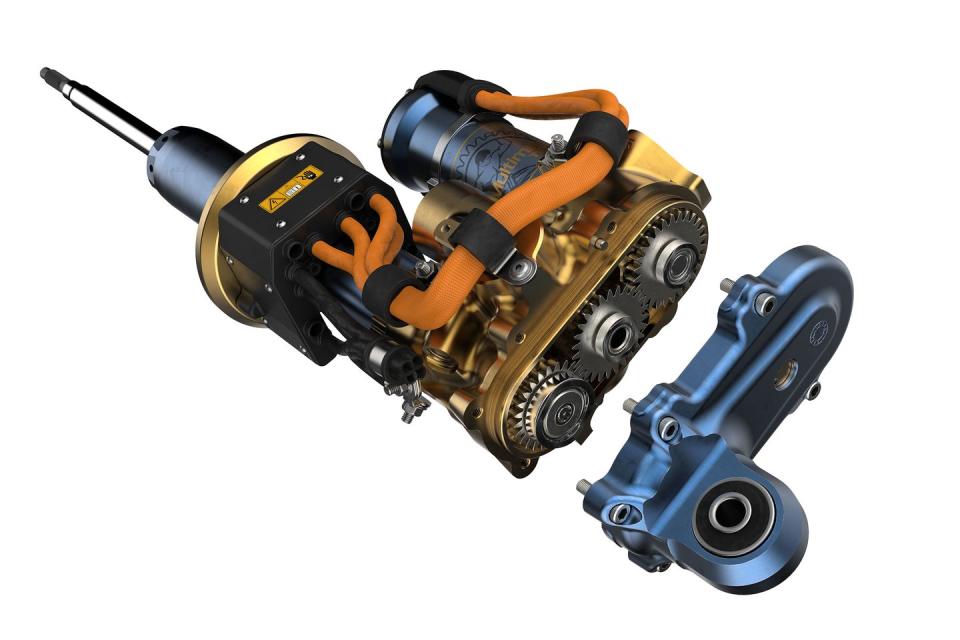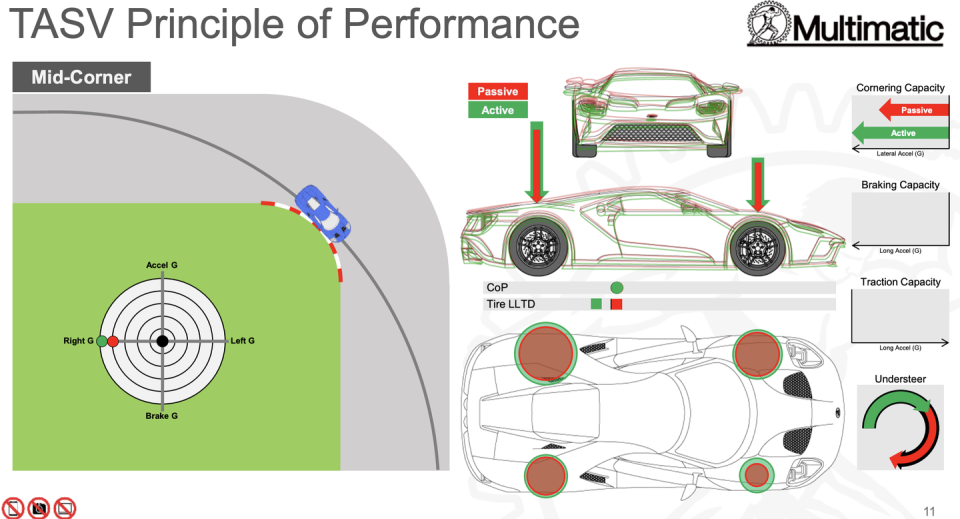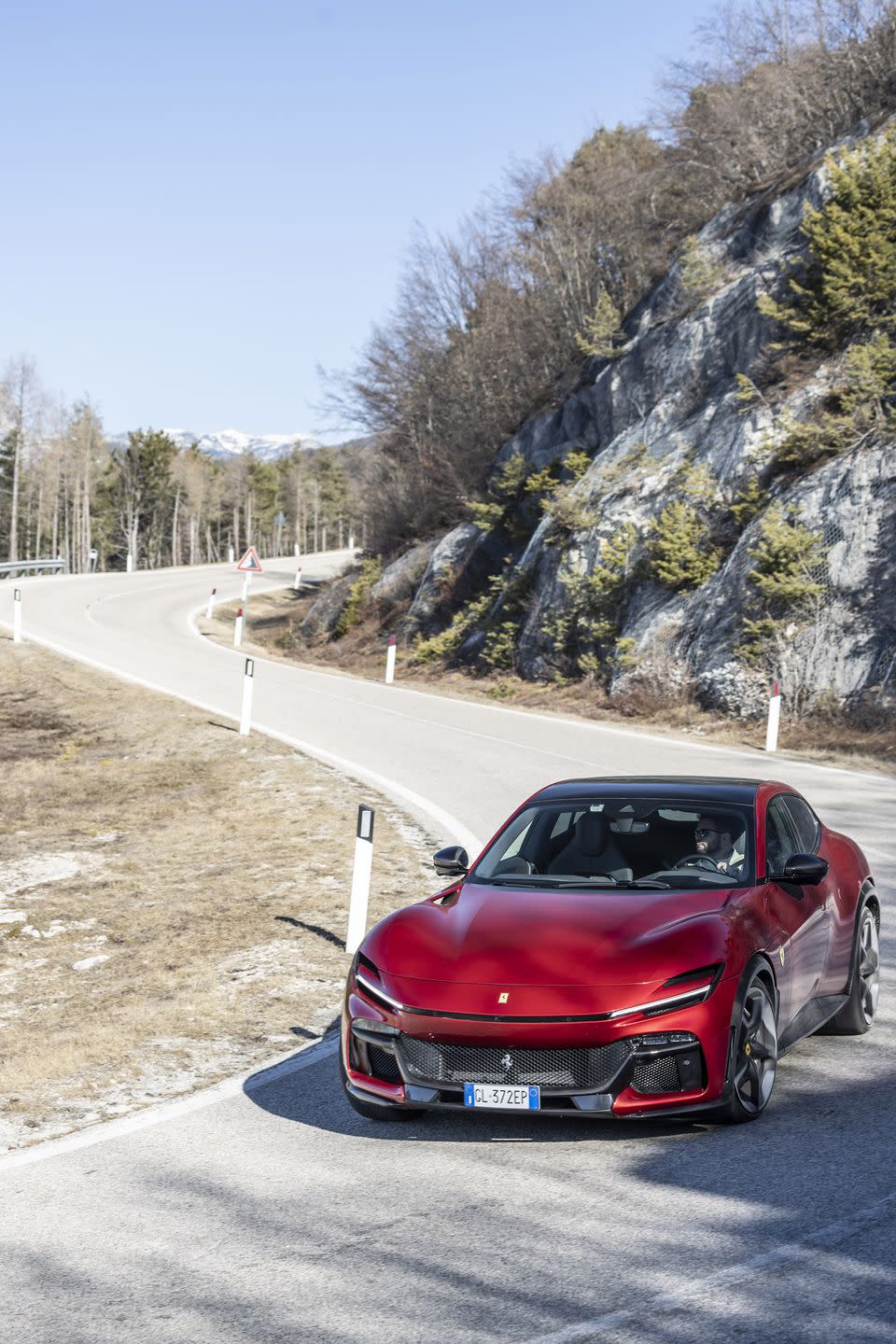The Hyper-Advanced Technology That Finally Makes Active Suspension a Reality

Active suspension is the be-all, end-all for vehicle dynamics. The ability to decouple ride from handling entirely and have total control over body motions is the dream of engineers, but until now, no one has managed to do it practically.e Multimatic's brand-new True Active Spool Valve (TASV) dampers have made the dream a reality. TASV is, in the truest sense of the phrase, a game-changer.
In a TASV damper, a brushless 48-volt motor controls the motion of a ball screw attached to the damper piston via a small gear train. We've had adaptive suspension for some time now, but all those systems are reactive. TASV is truly active, hence the name, the motors allowing you to put force into the suspension, independent of the road surface beneath. In a TASV car, the only thing linking the dampers is a cooling system for the motors—there's no hydraulic lines running between them, and no anti-roll bars linking left and right. TASV made its debut in the new Ferrari Purosangue, integrated into a system called Ferrari Active Suspension Technology (FAST). Developed in-house by Ferrari using TASV hardware as a base, FAST integrates the suspension with all other chassis systems to optimize driving dynamics.
Before we go further, let's take a quick step back. Active suspension has long been a dream of automotive engineers, but it's never quite worked out. Bose—yes, that Bose—famously spent decades working on active suspension, which used electromagnetic drivers to control each corner of the car in place of a traditional shock absorber. The system worked well over large road imperfections, but not smaller inputs. Plus, it added around 300 pounds to the car, and its 2200-psi hydraulic pump was a drain on the engine. The system was expensive, too, and Bose abandoned the technology. In the Eighties, Lotus developed a Formula 1-derived active suspension system that GM intended to put into production for the C4 Corvette ZR-1, but it also weighed and cost too much.
So what's different about TASV? After all, it also adds cost and weight to a car. It's just that it is a much lighter, less complex system than those setups of the Eighties and Nineties.
Multimatic is a Canada-headquartered firm that's best known for building race cars and making spool-valve dampers. The company's Dynamic Suspensions Spool-Valve (DSSV) damper is a marvel. Typical automotive dampers use thin shims on either side of the piston, and their deflection determines damping force. As the name suggests, DSSVs use spool valves in place of flexible shims, offering far greater damping control and increased durability. After being introduced 20 years ago, DSSVs became a must-have in racing, and soon trickled into specialized road cars.
Undoubtedly high-tech, but Multimatic is quick to point out that these are still a passive system. No electronic controls, or anything else. Many of today's high-performance cars demand more flexibility than any passive damper could ever offer, though. Multimatic first brought out a version of the DSSV with three driver-selectable settings for the Ford GT—a car it builds for Ford—and in 2021 unveiled an evolution of this, the Adaptive Spool Valve (ASV), which offer continuous adjustment of compression and rebound damping via 32 preset force-velocity curves. Its latest hardware, the True Active Spool Valve (TASV) damper takes all this to its logical endpoint.
The basic idea is simple—take an ASV damper and add an electric motor, and the result is, perhaps, the ultimate automotive suspension system, a significant step beyond today's adaptive dampers. "Although [a traditional] adaptive system can change its [force-velocity] curves… that damper, by definition, can only absorb energy," Multimatic president Raj Nair tells Road & Track. "So whether it's stroking up or stroking down, in jounce and rebound, it's absorbing energy and you're changing the amount of energy it can absorb. That's where we draw the line of adaptive damping to what we're going to get to. A true active suspension can put energy into the suspension."
TASV allows for totally independent control of all four wheels, obviating the need for anti-roll bars. Mercedes offers a suspension system, E-Active Body Control, that also does without anti-roll bars, but it relies on hydraulic pumps. McLaren also has a no-anti-roll-bar suspension system, Proactive Chassis Control, but that too uses hydraulic lines, in this case to interconnect opposite corners of the car. A TASV damper is a discrete unit, with a 48-volt motor working directly on the piston.
"You have total authority over the car," says Peter Gibbons, Multimatic technical director for vehicle dynamics. "Pitch, roll, heave, lateral load transfer, anything you want. You can optimize the aero, have total control of the platform…it's the dream."
These liquid-cooled, brushless, Multimatic-designed motors are small, yet mighty, capable of adding nearly 5 kilonewtons (1120 pounds) of supplemental force at each corner. Multimatic worked hard to ensure these motors had ultra low inertia as well, since they have to move quickly in order for a system like this to be effective in the first place.

The end goal is to optimize for what both a driver and tire wants. There's a lot of overlap between the two, but they are not one in the same. While any automaker that uses TASV will develop control algorithms in-house, as Ferrari did for the Purosangue, Multimatic developed its code to explore what's possible with the system, and to prove it was worth pursuing for production.
"From a driver's perspective, it's about disturbance rejection, right?" says Michal Guttila, Multimatic VP of engineering. "We're trying to minimize the load variation that you feel as a driver through the seat, through your hands from ride disturbances, but also from some of your own driver control inputs, and then that starts to get into optimizing what we call planar handling response." That is, essentially, linear, predictable handling—the car does what you expect it to.
"A tire wants to have the maximum amount of load possible for a given vehicle weight…But really as drivers, we can only drive to the minimum load at tire contact patch and that's going to limit your traction and cornering capability," Guttilla continues. "Not the average load it sees through a corner, but the minimum." Reducing fluctuations in load means increasing tire grip, but doing so with traditional suspension components usually means resorting to high spring rates and low ride height. That's fine in a race car, but obviously not what anyone wants in a road car.
With a TASV damper, there's no need to use ride-ruining stiff springs or thick anti-roll bars to ensure high cornering grip. These dampers are meant to be fully integrated into a vehicle's systems to work proactively. "Just for example," Guttilla says, "when you turn the wheel of a car, you know, based on its CG height, we have a model embedded in our control algorithm that knows how much it wants to roll. So we know how much force we need to add in to take that roll out and it has nothing to do with how much the car's even moved. We put that force in ahead of the car even moving."
A Ford GT test car equipped with TASV dampers and Multimatic-developed software lapped Calabogie Motorsports Park in the simulator 1.9 seconds faster than a GT equipped with its ASV dampers, itself a second quicker than a standard car. So nearly a 3 second improvement over a 3.14-mile long track. Helpfully, the company made an infographic comparing what happens in the three phases of a corner between a standard GT, one with ASV dampers, one with TASV dampers.



Note that the above slides don't represent an actual car, rather a virtual prototype developed by Multimatic.
"We can lower [a car's] CG as we're going into a corner," Guttilla explains. "That reduces the amount of load transfer." All of this ensures better stability on turn-in, which in turn helps with mid-corner performance. "You typically would be stuck with the vehicle rolling to the outside. You have the amount of load transfer that exists, but now what we do is again, we lower its CG. We decrease the amount of load transfer from the inside tires to the outside tires and we start to migrate that lateral load transfer distribution rearward. So now we get a neutral balance on the car because we can afford to, because we're not worried about that stability on that turn entry." On exit, a TASV-fit car is set up to squat down on its rear tires while also moving the lateral load transfer forward, increasing traction. Nair says it feels like the car gains traction even on exit curbing.
There are other benefits, too. In higher-downforce road cars—becoming a more common thing as drivers seek more track performance—the shocks help maintain the center of aerodynamic pressure, increasing stability significantly. The dampers can even roll the car in the opposite direction, not that you'd necessarily want to do that, as the feeling would be quite unnatural.
Late last year, Multimatic invited me to its facility outside Detroit to try TASV in the simulator. I didn't get much track running in—read why here—but driving a virtual Ford GT equipped with TASV on some simulated real-world roads was illuminating. Multimatic engineers allowed me to A/B the standard GT with the TASV-equipped car, and the latter was both more comfortable and confidence inspiring. Where the standard GT almost felt like it was beating the road into submission, the active-suspension car breathed with the ever-changing surface of simulated UK and Detroit Metro roads.
Yet what's clever is that the active car didn't feel weird whatsoever. It just felt like a sports car with really well-sorted passive suspension. To do so requires careful calibration work, as TASV offers so much fidelity, you could make the car do unnatural things, like lean the opposite way into corners, or eliminate roll, pitch, and dive entirely. Then there's the benefit of basing the system around the already-excellent spool-valve damper. A Magnetorheological damper creates force-velocity curves by using an electromagnet to change the viscosity of the fluid within the damper; TASV has a range of real force-velocity curves and the extra precision of a spool valve.

Last month, I had the opportunity to test TASV in the Ferrari Purosangue. Ferrari has worked magic here. This is the biggest, heaviest Ferrari yet the ride and handling suggest a much smaller, lower car. It rides beautifully, and the handling is far, far better than any other high-riding vehicle.
So, why does Multimatic bother with DSSVs and ASVs if TASV dampers are well and truly the ultimate? Cost, basically. "It's always a performance-versus-cost relationship, right?" Guttila says. "You don't need the 48-volt system. You don't need a very nice compact, low inertia, very powerful, but pretty expensive motor, and you don't need the gear system. So it's quite a bit of a cost difference between ASV and TASV," Nair adds.
In many cases, however, the cost will be worth it. Based on my time experiencing the system in both the virtual and real worlds, there's nothing like it. For a vehicle dynamics engineer, it's the logical endpoint in suspension design. The best of the best.
You Might Also Like

 Yahoo Autos
Yahoo Autos 